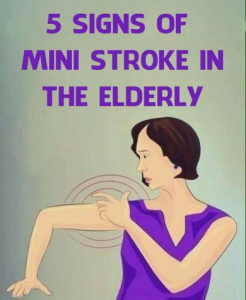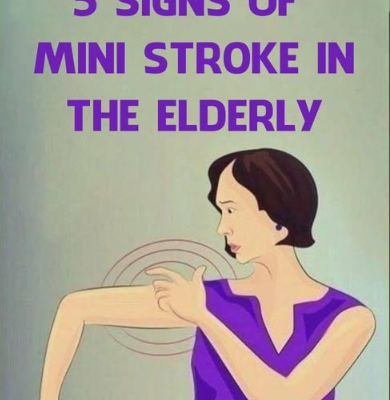
A mini stroke, medically known as a transient ischemic attack or Transient ischemic attack (TIA), is a warning sign that should never be ignored. Although the symptoms may disappear within minutes or hours, a TIA can indicate that a major stroke is likely to follow if preventive measures are not taken. This condition is especially concerning among older adults, as age significantly increases the risk. Many people overlook a mini stroke because it can present subtly, but early recognition can save lives. Understanding both common and unusual symptoms in the elderly is crucial for timely treatment and prevention of long-term damage.
What a Mini Stroke Is
A TIA occurs when blood flow to a part of the brain is briefly interrupted. Unlike a full stroke, the blockage is temporary, and brain cells do not typically suffer permanent damage. However, the event is a red flag: it means that something is interfering with blood circulation to the brain, such as a small clot or narrowed arteries. About one in three people who experience a TIA will go on to have a full stroke, often within a year. For seniors, whose blood vessels may already be weakened by aging and other health conditions, the risk is even higher.
Why the Elderly Are More Vulnerable
Elderly individuals are more prone to TIAs for several reasons. First, aging naturally leads to stiffening and narrowing of arteries, which can increase the chance of clots forming or lodging in the brain’s blood vessels. Second, chronic conditions common in older adults—such as Hypertension, Atrial fibrillation, Diabetes mellitus, and Hyperlipidemia—can significantly elevate stroke risk. Lastly, some seniors may already have mild cognitive or physical impairments, making it harder to notice or report new symptoms quickly.
Common Symptoms of a Mini Stroke
Recognizing the classic warning signs can be the difference between full recovery and a devastating stroke. The acronym FAST is widely used to identify common stroke symptoms:
-
F – Face Drooping: One side of the face may suddenly droop or feel numb. A simple way to test this is to ask the person to smile. If the smile is uneven, this is a red flag.
-
A – Arm Weakness: The person may have weakness or numbness in one arm. Asking them to raise both arms can help spot any sudden weakness.
-
S – Speech Difficulty: Slurred speech, difficulty finding words, or an inability to speak coherently can signal a TIA.
-
T – Time to Call Emergency Services: Even if symptoms disappear quickly, immediate medical attention is critical.
But beyond these classic signs, TIAs can produce other symptoms, especially in older adults, that may be mistaken for something less serious.
Unusual or Less Obvious Symptoms in the Elderly
While many people associate strokes with facial drooping and slurred speech, a mini stroke can also cause subtler symptoms that are easy to miss:
1. Sudden Confusion or Forgetfulness
Elderly individuals may suddenly seem confused, disoriented, or forgetful. This can be mistaken for ordinary “senior moments” or dementia-related lapses. The key difference is that TIA-related confusion comes on suddenly and may last only minutes or hours.
2. Dizziness and Loss of Balance
Many seniors already experience balance problems, but a sudden loss of coordination or trouble walking in a straight line can indicate a TIA. Some may feel lightheaded, stumble, or need support to stand.
3. Temporary Vision Changes
A TIA may cause blurred vision, double vision, or even sudden temporary blindness in one eye. Older adults might dismiss this as eye strain or a problem with their glasses, but it can be a critical warning sign.
4. Numbness or Tingling in Unusual Places
Instead of affecting just one side of the body, TIAs in seniors may produce tingling sensations in areas like the hands, lips, or legs. This sensation may come and go within minutes, making it easy to ignore.
5. Sudden Fatigue or Weakness
Some elderly individuals may feel an overwhelming sense of tiredness or weakness, as if their energy has been “drained” in seconds. They may sit down suddenly, feel faint, or appear pale.
6. Personality or Behavior Changes
Because TIAs affect the brain, they can briefly alter mood or personality. A calm person may suddenly appear irritable, anxious, or withdrawn. Family members might mistake this for stress or confusion, but in combination with other symptoms, it may point to a mini stroke.
7. Headaches or Pressure Sensations
While TIAs are not typically painful, some people—especially older adults with vascular problems—may experience sudden headaches or a feeling of pressure in the head. This can be confused with sinus issues or tension headaches.
Why TIAs Are Dangerous Even When Symptoms Fade
One of the most misleading aspects of a TIA is that symptoms usually fade away quickly, often within an hour. Because of this, many elderly individuals and their families decide to “wait and see” instead of seeking immediate help. This is dangerous. The disappearance of symptoms does not mean the problem is gone. In fact, it often means the body narrowly avoided a major stroke. Medical intervention at this stage can prevent a catastrophic event.
Immediate evaluation after a TIA can reveal underlying problems such as blood clots, narrowed arteries, or irregular heart rhythms. Treating these issues early may involve medications like blood thinners, procedures to open blocked arteries, or lifestyle changes to reduce risks.
Diagnostic Steps After a Mini Stroke
When an elderly person is suspected of having a TIA, emergency medical professionals typically perform several tests:
-
Neurological examination to assess speech, coordination, strength, and reflexes.
-
Brain imaging using Magnetic resonance imaging (MRI) or Computed tomography (CT scan) to detect any early signs of stroke or other abnormalities.
-
Blood tests to check for clotting disorders, cholesterol levels, and blood sugar levels.
-
Electrocardiogram (ECG) or other cardiac monitoring to identify heart rhythm problems that could contribute to clots.
-
Carotid ultrasound to examine blood flow in the neck arteries.
Early diagnosis is essential because treatment after a TIA is aimed at preventing the next, potentially much more damaging stroke.
Treatment and Prevention Strategies
Treatment for a mini stroke focuses on addressing the underlying cause and reducing future risk. Common strategies include:
-
Medications:
-
Blood thinners to reduce clot formation.
-
Blood pressure medications to manage Hypertension.
-
Cholesterol-lowering drugs to prevent artery narrowing.
-
Medications to manage heart rhythm disorders.
-
-
Surgical or Interventional Procedures:
If a blockage or narrowing is found in major arteries, doctors may recommend procedures like Carotid endarterectomy or stenting to restore blood flow. -
Lifestyle Changes:
Reducing salt intake, quitting smoking, exercising regularly, and managing stress can lower stroke risk dramatically. -
Monitoring and Follow-Up:
Elderly patients who have had a TIA need regular medical checkups, including monitoring of blood pressure, cholesterol, and heart rhythm.
The Role of Family and Caregivers
For seniors, caregivers and family members often play a crucial role in recognizing symptoms and seeking timely medical help. Elderly individuals may downplay or misunderstand what is happening. Families should be alert to sudden changes in speech, behavior, balance, or alertness. When in doubt, it is always safer to call emergency services immediately.
Acting quickly can make a life-saving difference. Medical guidelines emphasize that treatment within the first few hours after a TIA or stroke can significantly reduce the risk of permanent brain damage.
Living Well After a Mini Stroke
Many elderly individuals recover fully after a mini stroke, especially if they receive prompt medical care. But recovery is also an opportunity to make meaningful changes. Managing chronic conditions like Diabetes mellitus, high blood pressure, and heart disease can dramatically lower the chance of a full stroke. Engaging in light physical activity, eating a heart-healthy diet, taking prescribed medications, and staying socially and mentally active can all contribute to better long-term health.
Equally important is education. Seniors and their loved ones should learn to recognize the signs of a TIA or stroke so they can act fast if it happens again. Time is everything when it comes to brain health.
Conclusion
A mini stroke may seem harmless because symptoms often vanish quickly, but it is one of the most serious warning signs a body can give. For the elderly, recognizing both the classic and subtle symptoms can mean the difference between prevention and a life-altering stroke. Sudden confusion, balance problems, temporary vision loss, or even mood changes should never be brushed off. Immediate medical attention after a TIA provides the best chance to prevent a more devastating stroke in the future. Awareness, quick action, and long-term care can protect both health and quality of life.

